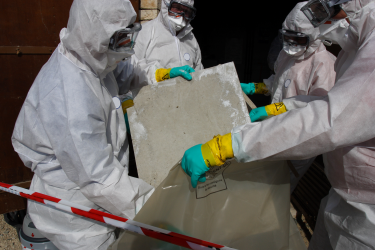What are the health risks of asbestos?
Get instant, expert answers to your HR questions...

Peninsula Team, Peninsula Team
(Last updated )

Peninsula Team, Peninsula Team
(Last updated )
The Institute of Occupational Safety and Health (IOSH) are leading calls for the Government to take more action to prevent thousands of deaths every year caused by asbestos exposure.
IOSH’s announcement comes amid Global Asbestos Awareness Week (1-7 April), aiming to increase awareness by working with policy makers, regulators, employers and worker representatives.
25 years after the full ban imposed on importation, supply and use of asbestos, it’s estimated that 300,000 non-domestic buildings built before 1999 still contain asbestos.
Technically, undisturbed asbestos poses a low risk – however, many of these older buildings need refurbishment and retrofitting. This means disturbing the deadly material and putting tradespeople and building occupants at risk if the process isn’t properly managed.
Ruth Wilkinson, Head of Policy and Public Affairs at IOSH, said:
“We know that about 5,000 people a year die from asbestos-related diseases every year in the UK. While the cause of their illness was likely exposure from decades ago, we believe that people are still being exposed today, putting them at risk of terminal cancers such as mesothelioma in the years to come.
Of the 5,000 deaths a year quoted by IOSH from Health and Safety Executive (HSE) figures, 2,500 are attributed to mesothelioma, a disease that can only be caused by asbestos exposure.
Get instant, expert answers to your HR questions...
Whilst this itself is a staggering number, the true figure may be much higher. Charles Pickles, lead campaigner and founder of the Airtight on Asbestos campaign, points to a 2023 paper by HSE scientist Lucy Darnton, who suggests a ratio of eight lung cancer deaths for every mesothelioma death.
If correct, this would amount to 20,000 asbestos-related deaths a year. Many of those deaths are the result of exposure to asbestos before the ban came in – mesothelioma can take 10 to 50 years to develop. Ruth Wilkinson said of the HSE figures:
“This is unacceptable. What is of significant concern is the lack of consistency in managing asbestos among duty holders and a lack of awareness and knowledge about it among those who are coming into contact with it, particularly in smaller businesses.”
Proposals by the Work and Pensions Committee for a 40-year deadline to be set for the removal of asbestos from all public and commercial buildings were reportedly rejected by the Government in July 2022. This has prompted IOSH to call for a combined effort to tackle the asbestos issue:
“While we supported the committee inquiry and the recommendations, we did highlight that there are still hazards and risks associated with removal,” added Ruth.
“What we’d really like to see is a collective effort by policy makers, government, regulators, employers and worker representatives to address this.
“Within the UK this can be part of a national strategic plan which is aligned to the built environment and net zero initiatives, as is it expected that buildings will require maintenance, renovation or demolishing as part of that agenda. Such a plan must therefore have a focus on duty holders, the duty to manage asbestos, and the competence of individuals and include the development of clear guidance around managing asbestos.
“It should also include enforcement. Also essential to it is improved training for employees which raises awareness of the dangers of exposure, informs them how to deal with asbestos and what to do if they come across it.
“Nearly two years have now passed and there hasn’t been any progress. Action is needed now. People’s lives depend on it.”
Visit BrAInbox today where you can find answers to questions like How should I dispose of asbestos waste?
When AI meets 40 years of Peninsula expertise... you get instant, expert answers to your HR and health & safety questions
